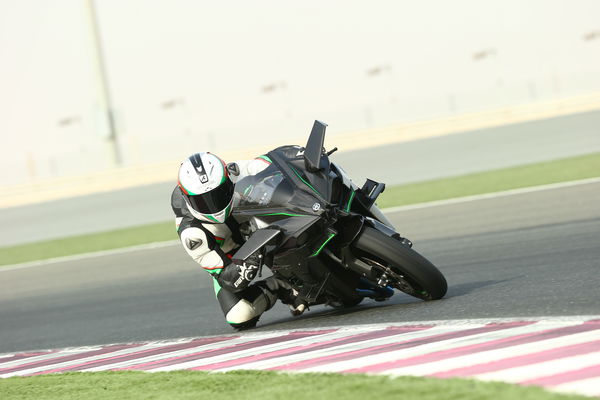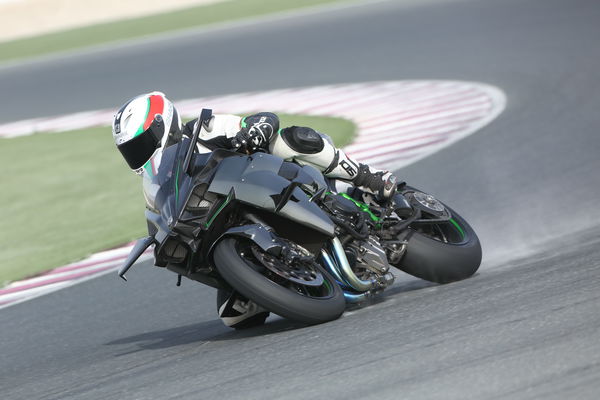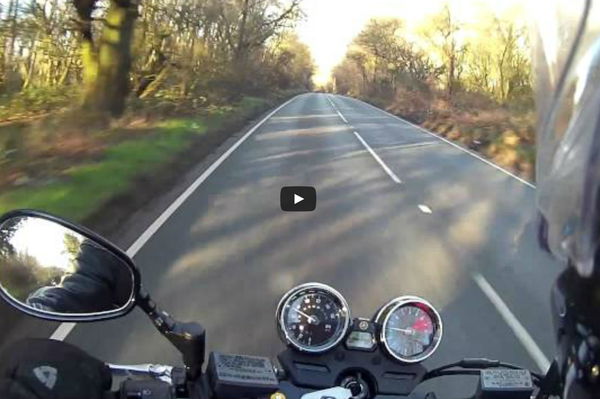First ride: Kawasaki Ninja H2 and H2R review
The Ninja H2R will probably remain the most sensational motorcycle I’ve ever ridden


KAWASAKI'S Ninja H2 and H2R have to be two of the most intimidating motorcycles I’ve seen in a long time.
They’re sharp and aggressive. There’s oodles of carbon fibre dripping off the R. And each is finished in a unique mirrored paint mixed with a layer of pure silver. Both have 998cc engines mated to a whopping great big supercharger, and as if that wasn’t enough, the track-only H2R has aerodynamic winglets to keep it on the ground at high speeds.
In a world where bikes are sold on the merit of mind-numbingly boring MPG figures, high service intervals and convenient 0% finance deals, it’s nice to know there’s a counter-balance out there in the form of a 240mph production motorcycle capable of physically taking off in sixth gear.
The build-up to the launch was just as serious as the bikes. Each week saw a new teaser video followed by the occasional audio clip of what sounded like an H2R tearing a dyno apart.
And for a change, it was clear Kawasaki wasn’t even remotely interested in making the pair sound suitable for novice riders either. The press conference for the H2s was devoid of any mention of A2 restrictor kits and the like. Instead it was littered with promises of intense acceleration, huge power output, and a riding experience unrivalled by any other motorcycle.
It’s fair to say Kawasaki had our attention.
The funny thing is, bike launches tend to consist of small groups of slightly overweight men, each one more immature than the next, riding like 16-year-olds who’ve just bought (stolen) their first moped. Wheelies get pulled, so do stoppies, and there’s obviously the occasional skid for good measure too. It's all good fun.
But this press launch was different. I couldn’t tell whether it was nervous excitement in the air, or perhaps just respect for the machines; whatever it was could be felt by all as it wafted around the pit garage at the Losail circuit in Qatar. Everyone was serious. Everyone.
Having now ridden both machines - somehow unscathed - words are waiting to pour out of me to describe in detail just how sensational the H2R is. But like Kawasaki’s teaser campaign, I’m going to make you wait a bit longer.
And so we swung a leg over the H2 for the first track session of the day. And what do you notice first? Well, the stainless steel exhaust system is whisper silent, the seat tapers in at the front helping the bike feel incredibly narrow, and that mirror-finish is clever in ways even Kawasaki engineers couldn’t have imagined. Catching my reflection in the tank, I noticed I’d forgotten to zip up my leathers seconds before riding out of the pits in the excitement of it all.
Losail is a featureless circuit with no elevation changes and numerous sections that look identical to the last. Fair enough I guess, it’s difficult to expect much else from a track located in the middle of a desert. Temperatures over 30 degrees meant that heat haze glimmered over each corner, twisting and turning every apex into a moving blur. Having never ridden there before, it’s fair to say my lap times weren’t going to have any GP riders worrying. But messy throttle inputs can occasionally be handy, and in this case they highlighted the settled nature of the H2’s chassis. Unlike the new Ducati 1299 Panigale, which pogos forwards and backwards on jerky throttle inputs, feels stiff, and constantly wants to sit up unless you’re 100% committed, the H2 feels compliant and forgiving, even when you don’t know where the next corner is.
Much of that is thanks to the H2’s candy green trellis frame and the fully-adjustable KYB suspension that manages to seamlessly intertwine composure, comfort and confidence at any speed.
But you’re here to hear about the supercharged engine.
Now, if you flew to Japan and told Kawasaki engineers that the H2 was merely a ZX-10R with a supercharger bolted on, you could expect a slap in the face. A large, painful one.
The engine is new from the ground up and was designed specifically for the supercharger that was also built completely in-house by Kawasaki’s motorcycle, gas turbine and aerospace divisions. That means the supercharger is tailored to the H2; it’s lightweight and so efficient it doesn’t even need to run a bulky intercooler. It means you get a large spread of power just about anywhere and everywhere.
It also means this bike is ******* quick.

It immediately became obvious why Kawasaki had hosted the event at Losail as I approached the circuit’s never-ending 1,068m straight. Driving out of the last corner onto the endless ribbon of tarmac, the H2 devoured it’s six gears as quickly as my foot could feed it upshifts. Near the 14,000rpm red-line, the supercharger comfortably breaks the speed of sound six times over as it’s impeller whines to 140,000rpm, sucking in over 200 litres of air a second and then forcefully ramming it into the H2’s four cylinders.
It’s not raucous, nor is it uncivilised or brutal. There’s not a huge rush of power anywhere either, just constant, smooth drive that rushes the H2 to its electronically-limited 186mph top speed in no time at all.
Before I could even contemplate what the R’s extra 126hp was going to feel like, I’d reached the end of the straight and banged down four gears to set the bike up for corner entry - three down-shifts would have done but the flutter noise of the supercharger is simply too addictive to pass up.
A heavy handful of front brake confirms you won’t need anything more powerful than the Brembo monoblocs fitted to the H2. Even in 33-degree heat, the brake pads didn’t fade despite the bike’s relatively hefty 238kg wet weight and Losail’s numerous heavy braking zones.
With several sessions under my belt, I also began to understand in more detail what Kawasaki were getting at when they described the H2 as a ‘high-performance machine’, but not necessarily one designed for the track. Apparently the H2 was never designed to go out and beat superbikes, win races or set best lap times. It was designed as an all-round performance machine.
And so the H2’s handlebars are slightly taller and wider than on the ZX-10R for improved comfort. The rear-sets have also been moved for a roomier riding position - it’s a comfortable machine.
But that doesn’t mean it even comes close to being slow on circuit. After getting to grips with the relatively abrupt throttle response, the H2 can be flogged around a track at a fairly mind-boggling pace. And whatever time it potentially loses in the corners to thoroughbred superbikes, it more than makes up for in the straights in the form of 200hp and bucket-loads more torque than any superbike out there. Coming out of Losail’s first hairpin, a slow second gear left-hander, the H2 can’t help but lift up its front end under the sheer amount of grunt pushing it forward. And when second gear runs out, you keep the throttle pinned and let the bike’s quickshifter sort out the gear change. The system is smooth as anything, has great feel and isn’t overly sensitive like other quick-shifters I’ve tried *cough* BMW R1200R *cough*.
If I could improve one area on the H2 it would be its electronics package. There’s launch control, engine brake control and clever nine-stage traction control that probably saved me from more high-sides than I gave it credit for, but unlike many of the new 1000cc superbikes, a lack of lean angle sensor on the H2 means there’s no cornering ABS system. That also means the traction control system isn’t quite as clever as others on the market. The R1 has six gyros measuring pitch, roll, yaw, and what you ate for breakfast that morning. The H2 has none. It's an advanced system, but it's still a generation behind the rest.
There’s also no auto-blipper function on the quick-shifter, which means blipping the throttle on down-shifts if you don’t want to risk locking the rear wheel on high speed gear changes. It’s not an issue, but your hand won’t do it nearly as consistently as an integrated rider aid.
As I reminded myself that most people probably don’t care much about the above, I relaxed and simply enjoyed everything brilliant that the H2 has to offer: power, desirability and craftsmanship that shows up in components from the single-sided swing-arm to tiny bolts with impeccable finish, to gorgeous welding.
Even simple things like the Öhlins electronic steering damper, grippy seat and pegs, contribute to the unique riding experience, keeping you planted in the seat and in control of Kawasaki’s supercharged animal. The H2’s tail-unit can be adjusted into three different positions so the side bolsters hold you in place under heavy acceleration - that’s a pub trump card If I ever heard one.

The digital dash is as easy on the eyes as the rest of the bike and makes checking gear selection, speed, or simply a self-satisfying glance down at the flickering traction control light, a doddle.
Motorcycle journalists have a saying called ‘launch fever’, describing the manner in which it’s easy to shower a bike in praise when you’re riding it on perfect roads, in a beautiful country with a sunny climate. Not this time. Yes, Losail is an impressive place to ride, but I’m completely sure the H2 would feel just as special anywhere else in the world.
And so I pulled in from my last session on the H2, waved goodbye to that mono-headlight tucked into the middle of the bike’s front fairing, and said hello to the bike I’d been so anxiously waiting to ride.
Riding the H2R…
This is it. I’m looking at an H2R. This is the culmination of 20 teaser videos and Kawasaki’s idea of the pinnacle of performance. And now it’s between my legs.
From the rider’s seat, you’d do well to know you have an extra 126hp beneath you. In fact, the aerodynamic wings, carbon fibre front and side fairing, and titanium exhaust system are probably the only giveaways that you’re not riding just the standard H2.
But then you fire it up.
If you appreciate the sound of thunder, then you will appreciate the H2R. It is by far the loudest thing I have ever heard on two wheels. Louder than a MotoGP bike and louder than that time you were changing your exhaust to a slip-on and thought it would be amusing to momentarily run the bike with nothing but the downpipe. The H2R is louder than a loud thing without being obnoxious - it sounds incredible.
Down the straight at Losail, Kawasaki’s video team were recording the bike at 170dB. That’s 20dB louder than a jet plane taking off 25 metres away from your ear drums. An exhaust that will reduce the H2R's bark to track-legal noise levels is in the process of being developed and will soon be available at extra cost.
Pulling out onto the circuit the change in power delivery compared to the H2 was immediately noticeable. Surprisingly, the H2 makes more torque than the R below around 6,000rpm. Anywhere above that, and up where the H2’s power curve begins to tail off, the H2R’s simply rises and rises until it hits the limiter.
Despite the huge power increase, the R’s engine internals aren’t too dissimilar to the standard bike’s. There’s more aggressively timed camshafts, a different head gasket and a stronger clutch to deal with the larger power output. Away from the engine hardware, there’s also a different intake system on the R, using two carbon-fibre runners instead of the single plastic system on the H2, and naturally the ECU has undergone some fettling to deal with the change in cam timing. Other than that, the two bikes are identical.
Throttle response is nowhere near as crisp as a naturally-aspirated machine and the engine tends to stutter anywhere below the 5,000rpm mark. But get the H2R onto a straight and those niggles are a distant memory, literally.
So what does 326hp feeI like? I have never, ever, felt acceleration like it. First, second and third gear can only be described as ferocious, and it will happily throw the front wheel into the air at every and any opportunity. It will then churn through the remaining three gears with just as much urgency. Most of us reached an indicated 200mph before having to shut off for the first corner.
On a long enough straight, Kawasaki claims the H2R will reach 240mph - and I believe them. At 200mph, the R was still accelerating like a 600cc supersport in fourth gear.
And because the H2R weighs a whole 22kg less than the H2, it stops faster at the other end of the straight, turns in better, and offers more feedback when you’re inevitably leaning on the traction control to counter powerslide out of corners.
Averaging lap times were well over two minutes on the H2, and the R was a whole 11 seconds faster around the 3.3-mile-long Qatari circuit. In the hands of an experienced racer, I suspect the difference would be greater.
Forget base jumping, free climbing or high altitude slack lining. Kawasaki’s H2R is the ultimate thrill. Having tasted the madness of 326hp supercharged-goodness, I already feel sad about not knowing when I will again.
The Ninja H2R will probably remain the most sensational motorcycle I've ever ridden.
Watch our video review of the H2 and H2R
Model tested: Kawasaki Ninja H2 and H2R
Engine: 998cc inline-four supercharged
Price: H2 will cost £22,000, H2R priced at £41,000
Power: H2 - 200hp (210hp with ram air) at 11,000rpm | H2R - 310hp (326hp with ram air) at 14,000rpm
Torque: H2 - 98.5ftlb at 10,500rpm (103.5ftlb at 10,000rpm with ram air) | H2R 121.7ftlb at 12,500rpm
Kerb weight: H2 - 238kg | H2R - 216kg
Tank capacity: 17 litres
Seat height: H2 - 825mm | H2R - 830mm











